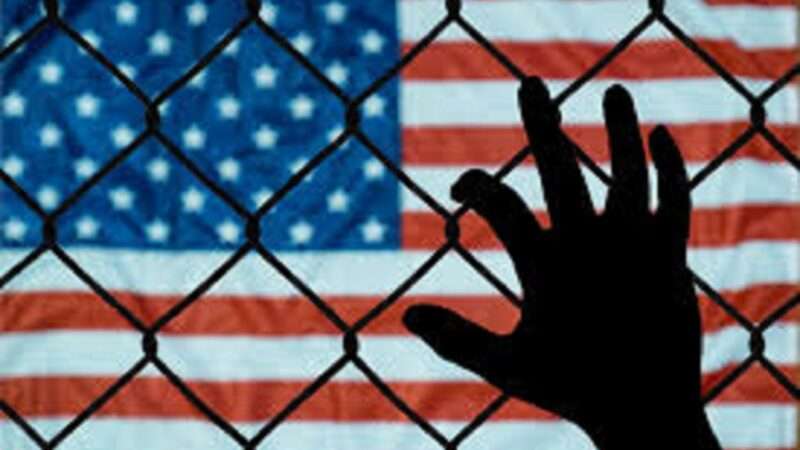

Many people say that illegal migrants should instead "get in line" and "wait their turn" to enter legally. In a new Cato Institute study, immigration policy expert David Bier explains why, for the vast majority, that simply isn't possible. For most there simply is no "line" that they can join. Even for many of those who are potentially eligible, the "line" is so long that it might take decades for them to get permission to enter—if it ever happens at all. In most cases, demanding that would-be immigrants wait in line is much like demanding that people who wanted to get a drink during Prohibition do so legally:
America traditionally had few immigration restrictions, but since the 1920s, the law has banned most aspiring immigrants. Today, fewer than 1 percent of people who want to move permanently to the United States can do so legally. Immigrants cannot simply get an exception to immigrate any more than restaurateurs in the 1920s could simply get an exception to sell alcohol. Instead, just as Prohibition granted only a few exemptions for religious, industrial, or medical uses of alcohol, people seeking an exception to immigration prohibition must also fit into preexisting carve‐outs for a select few.
Many Americans have the false impression that these carve‐outs are realistic options for potential immigrants to join American society, but the government's restrictive criteria render the legal paths available only in the most extreme cases. Even when someone qualifies, annual immigration caps greatly delay and, more frequently, eliminate the immigrant's chance to come to the United States. Legal immigration is less like waiting in line and more like winning the lottery: it happens, but it is so rare that it is irrational to expect it in any individual case.
This study provides a uniquely comprehensive, jargon‐free explanation of U.S. rules for legal permanent immigration. Some steps are simple and reasonable, but most steps serve only as unjustified obstacles to immigrating legally. For some immigrants, this restrictive system sends them into the black market of illegal immigration. For others, it sends them to other countries, where they contribute to the quality of life in their new homes. And for still others, it requires them to remain in their homeland, often underemployed and sometimes in danger. Whatever the outcome, the system punishes both the prospective immigrants and Americans who would associate, contract, and trade with them.
Bier methodically goes through every currently existing option for legal immigration and explains their scope and limitations. For example, as he points out, the refugee admissions system is constrained by a narrow legal definition of who qualifies as a refugee, a tight annual cap (currently 125,000) that the US nonetheless fails to reach because of bureaucratic obstacles, and other constraints. Along the way, Bier also dismantles some other common myths about immigration policy, such as that the US takes the majority of the world's migrants (it in fact only takes about 7.5%), and that it is more open to immigration than any other country (far from it).
Bier proposes a variety of useful reforms, such as abolishing discriminatory country-based caps for employment visas, eliminating long waits for visas of many kinds, and much else.
Much of what Bier covers is well-known to immigration policy experts. But the paper is a valuable overview for both specialists and interested laypeople.
Over the last two years, the combination of the end of the Covid pandemic and policy changes by the Biden administration has enabled the US to regain pre-pandemic and Pre-Trump levels of legal migration. But while Biden's changes have had a significantly liberalizing impact, Bier's paper shows they still exclude the vast majority of would-be migrants.
Bier's paper cannot and does not resolve all debates over immigration policy. A committed restrictionist could potentially read it, agree with all or most of its points, and conclude that the status quo is much better than he previously thought!
But it does have a number of policy implications, nonetheless. Bier catalogues many ways in which the current system is self-contradictory, undermining its own stated objectives, such as preventing family separation and attracting workers to industries with labor shortages.
The extraordinary difficulty of legal migration also undercuts arguments that migrants have a moral duty to "get in line" rather than try to enter illegally. The near-impossibility of legal entry for most strengthens the case that they are morally entitled to disobey immigration laws, especially in situations where the alternative they face is a lifetime of poverty, violence or oppression.
The paper also has implications for the ongoing public debate over disorder at the border. Most of that disorder is in fact caused by restrictions on legal migration, which incentivize people fleeing horrific conditions to try illegal routes instead (the only ones available to them). Just as Prohibition predictably led millions of people to purchase alcoholic beverages from organized crime, so severe immigration restrictions predictably lead migrants to cross illegally or seek out the services of smugglers.
The best way to reduce illegal alcohol sales and the involvement of organized crime in that industry was to end Prohibition. Similarly, the best way to reduce illegal border crossings and associated problems is to make legal migration easier, as the Biden Administration has begun to do with its CNVH parole program, a policy that has significantly reduced illegal border crossings by migrants from the four nations it covers.
I do have a few quibbles with Bier's analysis. Most notably, I think the estimate that 158 million people (based on surveys) would migrate to the US if legal barriers were dropped is probably an overstatement. It doesn't take account of various moving costs associated with migration, which respondents may not consider when answering survey questions (e.g.—the cost of learning a new language, finding a job, etc.). It also does not consider constraints imposed by employment and housing markets. In a section of Chapter 6 of my book Free to Move, I discuss the limitations of such estimates in more detail.
It may be that the current system bars "only," say, 80 or 90 percent of would-be migrants to the US, as opposed to Bier's estimate of 99%. But even the lower figure is enough to show the severely restrictive nature of the status quo—and the ways in which it consigns many millions of people to lives of poverty and oppression largely because of morally arbitrary circumstances of ancestry and place of birth. As Bier notes, the system also severely constrains the liberty and economic opportunities of native-born Americans.
The post Why Legal Immigration is Almost Impossible for the Vast Majority of those Who Want it appeared first on Reason.com.







